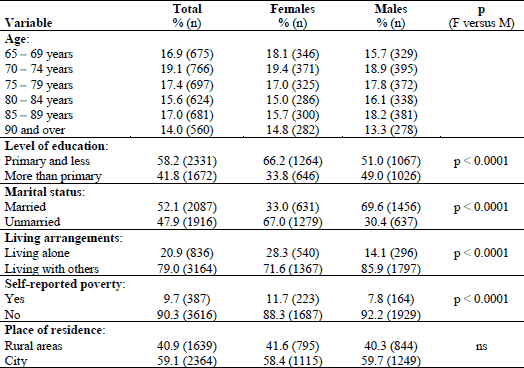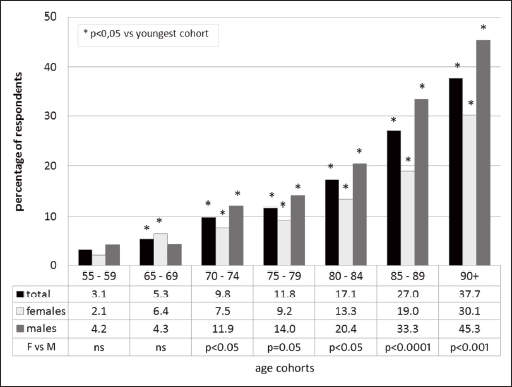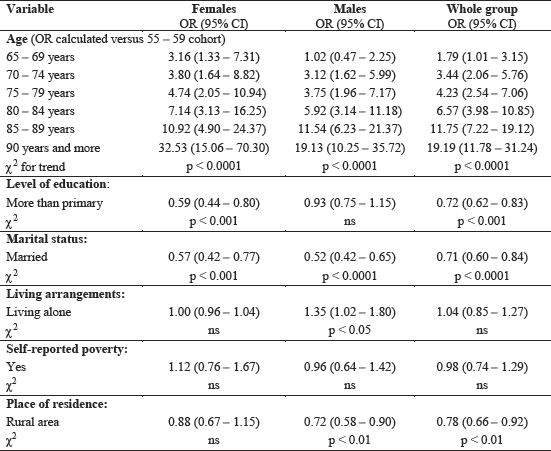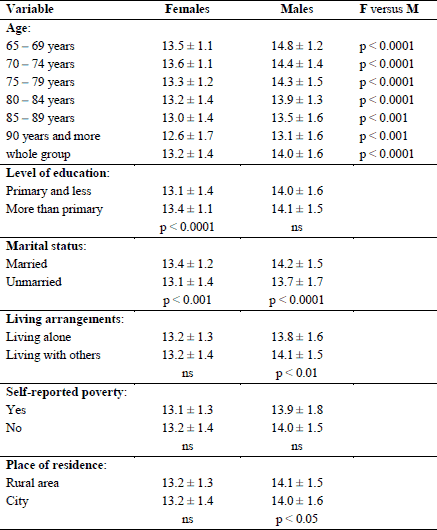PREVALENCE OF ANEMIA IN RELATION TO SOCIO-ECONOMIC FACTORS IN ELDERLY POLISH POPULATION: THE RESULTS OF POLSENIOR STUDY
INTRODUCTION
The process of aging of today’s societies can be observed worldwide. It includes both increasing number of older people as well as their percentage in the populations. Based on the United Nation report from 2017, there are 962 million people aged 60 or over and this number is projected to reach 1.4 billion in 2030 and 2.1 billion in 2050. The global ratio of people aged 60 and more is expected to grow from today's 13% through 16% in 2030, to 21% in 2050 (1). The number of ‘oldest-old’, people aged 80 years or over, is growing even faster. Projections indicate that in 2050 the number of oldest-old will reach 434 million, having more than tripled since 2015, when there were 125 million people over age of eighty (2).
Aging of the population puts pressure on health systems, increasing the demand for care, services and technologies to prevent and treat non-communicable diseases and chronic conditions associated with old age (2). Since the longer life may be associated with higher probability of loss of independence, it is important to put attention to common medical problems affecting older people, especially those whose importance is not widely recognized. Anemia is one of these conditions. In the Established Populations for Epidemiologic Studies of the Elderly (EPESE) project performed in the United States, in four-year observation anemia was identified as an independent risk factor for higher hospitalization rate and more extended stay, as well as higher mortality (3). Anemia in old age may result in more reduced muscle strength and physical performance, leading to the increased risk of falls and depression, as well as deterioration of cognitive functions (4-6). The significant functional deterioration and increased mortality rate among older anemic individuals may, at least partly, result from age-dependent worsening of compensatory mechanisms such as endothelial angiogenesis induced by hypoxia (7).
According to the WHO criteria formulated in 1968, anemia is defined as a hemoglobin (Hb) concentration < 13 g/dL in men and < 12 g/dL in women (8). Despite the difference in opinions whether these values are adequate to define anemia in older people, there is no widely accepted alternative definition of anemia in this age group (9). Prevalence of anemia increases with advancing age and exceeds 20% in those aged 85 years and older (10). In nursing home residents it can reach 60%, as demonstrated in the analysis of data from a national archive of 379 nursing homes in the USA (11).
The high burden of comorbidity and accompanying polypharmacy among older adults make it difficult to determine the underlying cause of anemia in this population. The studies focused on the mechanisms of development of anemia point among others to possible effects of toxins which increase the risk of anemia (12). The process of aging involving phenomenon such as the increased levels of proinflammatory cytokines and decreasing androgens levels may contribute as well to low hemoglobin level in older individuals (13). It could be expected that a low socio-economic status might have a significant impact on the prevalence of anemia in older subjects. To the best of our knowledge, no previous reports based on the representative groups in any European country showed such association. Therefore, in this article, we analyze the social and economic aspects of aging and their impact on the prevalence of anemia based on the data from the PolSenior project, the first nation-wide study of a representative group of Polish seniors.
MATERIAL AND METHODS
PolSenior was a nation-wide multidisciplinary research project, conducted in 2007 – 2012, organized to assess medical, psychological, social and economic aspects of aging in Poland (14). The aim of the project was to define the current status of older subjects taking into account the above dimensions of aging as well as medical and social needs of Polish seniors.
The study protocol was approved by the Bioethics Committee of The Medical University of Silesia in Katowice. Informed consent was obtained from each respondent or their caregiver before the study.
There were 5695 people participating in the project; that number consisted of 4979 elderly individuals aged 65 years and older (2412 women and 2567 men) and a reference group of 716 individuals between 55 and 59 years of age, consisting of subjects who were just about to enter old age (384 women and 332 men). Study participants were selected through the multi-stage draw, planned to obtain a group representative for Poland. The selection of elderly population was performed independently in six 5-year age cohorts: 65 – 69 years (n = 782), 70 – 74 years (n = 923), 75 – 79 years (n = 844), 80 – 84 years (n = 791), 85 – 89 years (n = 871), 90 years and above (n = 768). A detailed description of study design has already been published (14).
Among 5695 study participants, blood was collected from 4737 persons; hematologic parameters failed to be measured in 112 people due to the technical problems (blood clots, hemolysis). Results from 4625 persons were involved in the analysis; this number consists of 4003 older participants of the study (1910 women and 2093 men) and 622 persons from the reference group aged 55 – 59 years, (333 women and 289 men). After being collected, the blood samples were delivered within 2 hours to local laboratories, where complete blood count was determined with automated analyzers. Anemia was defined according to the WHO criteria, hemoglobin level < 12.0 g/dl in females and < 13.0 g/dl in males (7).
Statistical analysis
Statistical analysis was performed with the STATISTICA 12 software (StatSoft, Poland). The frequency of anemia in the analyzed groups was compared with the use of χ2 test and extended Mantel-Haenszel χ2 test for trend. For hemoglobin level mean values and standard deviations were calculated. Comparison between two unpaired groups was made with the independent Student’s t-test and the Kruskal-Wallis test for more than two groups. In the case of significant differences between studied variables detected by the Kruskal-Wallis test, a post hoc Duncan test was performed. To assess interdependence between variables, multiple logistic regression was used, specifying the odds ratio and the confidence interval with the confidence limit of 95%. For logistic regression analysis, studied population was divided into two groups, persons 65 – 79 years old representing a younger-elderly population, and persons of the age 80 years and older representing an older-elderly population. Logistic regression analysis was performed, at first including the age and socio-economic parameters, separately in men and women. To avoid the situation in which the age as the strongest determinant of anemia overwhelms other variables, the logistic regression analysis was performed again with the sole consideration of socio-economic parameters. P value of < 0.05 was considered as statistically significant.
The sample was intended to include the same number of men and women in all age groups. It thus allowed for precise assessment of studied factors in the oldest groups. On the other hand, compared to the population structure, older groups and men were overrepresented. Consequently, to make the sample representative of the elderly Polish population and assure that the results reflected the distribution of anemia and the risk of its occurrence in the entire elderly population in Poland, post-stratification was necessary (14). The standardized prevalence of anemia in the Polish older population (aged 65 years and over) were calculated from these weighted values.
RESULTS
Of the 4003 older participants of the study with a mean age of 78.9 ± 8.6 years (range: 65 – 104 years), 47.7% were women. The detailed characteristics of the studied group concerning the social and economic variables are presented in Table 1.

Anemia was diagnosed in 17.4% of older persons (n = 695) and only in 3.1% of younger respondents aged 55 – 59 years (n = 19; P < 0.001). Among elderly, anemia was more frequent in men than in women (20.8% versus 13.6%; P < 0.001). The frequency of anemia progressively increased with age (Fig. 1) and the odds ratios in comparison with the reference group grew from 1.79 for the cohort 65 – 69 years old to 19.19 in nonagenarians (Table 2). As much as 45% of men aged ≥ 90 years were anemic. The value was 50% greater in men than in women of the same age. Based on these data, the standardized prevalence of anemia was estimated at 10.8% and equaled 9.4% in females and 11.5% in males.
 |
Fig. 1.The frequency of anemia in the Polish older population according to age and sex. ns, not significant. |
The mean level of hemoglobin decreased with age, starting from 14.1 g/dL in the youngest cohort of older respondents, to 12.8 g/dL in the oldest one. That decrease was more pronounced in men. However, even in the oldest, hemoglobin level was significantly higher in men than in women (Table 3).
Married men and women, as well as men living with others, had a lower occurrence of anemia and higher levels of hemoglobin than single ones and men living alone. The lower level of education was associated with higher odds of anemia and low hemoglobin level in women, but not in men. Older male (but not female) residents of rural areas had a lower frequency of anemia and higher hemoglobin levels. We found that self-reported poverty was associated neither with the prevalence of anemia nor the hemoglobin level (Table 2 and 3).


The multiple logistic regression analysis confirmed that age most strongly determined the occurrence of anemia in the aging population. None of the other analyzed variables was associated with the frequency of anemia in women. In men besides the age, the urban place of residence, and unmarried status were related to higher odds of anemia (Table 4).

The logistic regression analysis performed among women without age taken into account confirmed the interdependence link between anemia and low level of education, unmarried status and urban place of residence. In men, the analysis confirmed interdependence between anemia and unmarried status all well as the urban place of residence (Table 5).

DISCUSSION
The presented results derived from the representative group of Polish seniors aged ≥ 65 years point to the high prevalence of anemia. The standardized prevalence of this condition was estimated at 10.8%, which is much higher than in the group of people aged 55 – 60 years. The prevalence of anemia in Polish older persons is comparable to values obtained from similar studies performed on the representative groups of seniors in the USA and Italy. In the Third National Health and Nutrition Examination Survey (NHANES III) which included four thousand Americans aged 65 years and older, the prevalence of anemia was 10.6% (15). The study of Aging in the Chianti area (InChianti) performed in Italy showed the anemia prevalence in one thousand of 65 and more years old of 11.3% (4).
We demonstrated that the frequency of anemia increased with age also in Polish seniors and reached 37.7% in nonagenarians. A similar tendency was observed in the NHANES III study (15). The tendency to increasing prevalence of anemia in subsequent cohorts of the elderly population is confirmed by the study performed on the population of Polish centenarians. In that group the prevalence of anemia reached 29% in women and 57% in men (16). Progressing prevalence of anemia in the subsequent age groups reflects the contribution of age-related multimorbidity and polypharmacy to the physiological effects of aging, such as age-related changes in bone marrow (17,18). Proinflammatory cytokines production resulting from the aging process may be partly responsible for the higher probability of development of the anemia of chronic inflammation (19). Poor nutritional status leading to deficiencies of iron, folate, or vitamin B12 may account for one-third of all anemia in the old population (20). Renal insufficiency and the related decrease in production erythropoietin is also responsible for a large number of cases of anemia in older persons (15).
Age-dependent decrease in production of androgens may have a significant impact on decreasing hemoglobin level and increasing prevalence of anemia in aging men. Because of these reasons some researchers suggested to apply the same reference values of hemoglobin in older men as in women, 12 g/dL (21). However, studies performed by Izaks et al. seem to confirm correctness of the appliance of the WHO criteria, since ten years mortality in elderly men increases at the hemoglobin level below 13 g/dL (22). Another study supporting the application of the WHO criteria is that of Culleton et al. performed on seventeen thousand elderly persons from Calgary Health Region, where all-cause mortality was significantly higher when hemoglobin level lowered by 1 g/dL below values 13 g/dL in men and 12 g/dL in women (23).
The PolSenior study is the first nation-wide study of a representative group of the elderly population where the social and economic dimensions of aging were analyzed with attribution to hematologic parameters. Although the progressing age remains the strongest predictor of anemia in the elderly population, we observed a significant contribution of some socio-economic factors in senior men. In women effect of age on the frequency of anemia was so strong, that none of the socio-economic dimensions of aging revealed its influence on anemia frequency in the multiple logistic regression analysis. However, we confirmed interdependence between the frequency of anemia and several socio-economic parameters in women at the bivariate analysis and in multiple logistic regression without age as one of the analyzed variables.
We did not observe differences in the prevalence of anemia and hemoglobin levels between these participants who reported poverty and those who did not. This fact is puzzling since in another study performed on the same population it was proved that self-reported poverty was an independent determinant of malnutrition (24). Since malnourished older persons often suffer from a deficiency of the nutrients which are crucial in erythropoiesis (iron, folic acid, vitamin B12), one could expect a higher prevalence of anemia in needy seniors. However, it did not occur, probably because people who reported poverty formed a relatively small group (below 10% of the entire elderly population) and the differences did not pass the significance test.
In our study, the marital status was related to the frequency of anemia and hemoglobin level. Both married men and women had the lower frequency of anemia as well as the higher mean level of hemoglobin. Most of the single participants of the PolSenior study were widows/widowers with much smaller groups of divorced, separated from their spouses or those who were never married. Since bereavement can result in higher levels of pro-inflammatory interleukin-6 (IL-6), one may expect that widows and widowers may be at higher risk of anemia of chronic inflammation (25). More detailed study with etiologic stratification of anemia would be necessary to confirm this hypothesis. The effects of marital status on the prevalence of anemia is not fully reflected by the impact of living arrangement on that parameter. Although older men who live alone have a higher frequency of anemia and lower level of hemoglobin than those who live with others, such observation is not applicable to older women. It may at least in part result from the fact that women much faster overcome depression after the death of their spouse than men who remain depressed even after 6 – 10 years of widowhood (26). Another explanation of that diversity may be related to gender-specific differences in social behavior (i.e. tendency to participate in conversation and to search for the companionship greater in women than in men) and female experience in domestic skills such as cooking for themselves and lack of that ability in males resulting from traditional share of household tasks. After death of their wives many older men face the problem of learning new skills such as cooking, which may lead to malnutrition and anemia.
Poor education level is related to higher frequency of anemia and lower level of hemoglobin in senior women, but not in men. That difference may result from the fact that two-thirds of older women in the PolSenior study had only primary education or even less while approximately half of the elderly men were educated above primary school. Low level of education is linked to higher risk of impairment in cognitive function and depression, which are the factors predisposing to anemia (27).
An interesting finding is related to the higher prevalence of anemia among older persons living in cities compared to those living in rural areas. It cannot be excluded that the better availability of medical services in cities and more effective treatment of these chronic diseases which are symptomized by anemia lead to overrepresentation of respondents with these diseases in city population. In other words, we suspect relative absence of chronic diseases associated with anemia in rural elderly population as an effect poor availability of medical care and early occurrence of complications resulting in deaths (28). From the other side higher frequency of anemia in urban areas may be related to the fact that in cities seniors who live alone more often suffer from social isolation and its consequences than in the rural areas where the social networks are much more cohesive. Another explanation of higher frequency of anemia in older city dwellers is associated with possible long-term exposure to air pollution. That interdependence was confirmed in the study performed by Honda et al., in which high exposure to fine particle matter (PM2.5) and nitric dioxide (NO2) resulted in higher prevalence of anemia and lower levels of hemoglobin in older persons (29).
Our study has limitations. The analysis does not take under account characteristics such as lifestyle, diet, polypharmacy, coexistent chronic conditions. It seems likely, that many of these dimensions of elderly would affect hemoglobin level and risk of anemia with much higher strength than socio-economic factors. However, in this work, we do not perform the etiological analysis of anemia, but only indicate the socio-economic conditions of this disorder. In our analysis of economic status of subjects we used the self-reported poverty. That parameter is subjective but in our opinion it better reflects individual economic status than nominal household income or household income divided by number of people living together. We also believe that in rural areas despite poor nominative income the risk of malnutrition leading to anemia may be relatively low because basic food products can be obtained from own farm.
In conclusion, the prevalence of anemia in elderly Polish population is high and progresses in subsequent age groups. This progression is more pronounced in senior men than in women, reaching almost 50% in the oldest cohort. Besides the age, being unmarried and living in the city were the strongest socio-economic predictors of the risk of anemia. This observation may be addressed to medical professionals involved in primary practice as suggestion for often screening for anemia in the group of old persons.
Acknowledgements: This study was implemented under publicly-funded project No. PBZ-MEIN-9/2/2006, Ministry of Science and Higher Education.
Conflict of interest: None declared.
REFERENCES
- World Population Prospects: The 2017 Revision, Key Findings and Advance Tables. Working Paper No. ESA/P/WP/248. United Nations, Department of Economic and Social Affairs, Population Division, 2017.
- World Population Ageing 2015 (ST/ESA/SER.A/390). United Nations, Department of Economic and Social Affairs, Population Division, 2015.
- Penninx BW, Pahor M, Woodman RC, Guralnik JM. Anemia in old age is associated with increased mortality and hospitalization. J Gerontol A Biol Sci Med Sci 2006; 61: 474-479.
- Penninx BW, Pahor M, Cesari M, et al. Anemia is associated with disability and decreased physical performance and muscle strength in the elderly. J Am Geriatr Soc 2004; 52: 719-724.
- Penninx BW, Pluijm SM, Lips P, et al. Late-life anemia is associated with increased risk of recurrent falls. J Am Geriatr Soc 2005; 53: 2106-2111.
- Terekeci HM, Kucukardali Y, Onem Y. et al. Relationship between anemia and cognitive functions in elderly people. Eur J Intern Med 2010; 21: 87-90.
- Ahluwalia A, Jones MK, Szabo S, Tarnawski AS. Aging impairs transcriptional regulation of vascular endothelial growth factor in human microvascular endothelial cells: implications for angiogenesis and cell survival. J Physiol Pharmacol 2014; 65: 209-215.
- Nutritional Anemia: Report of a WHO Scientific Group. Geneva, Switzerland. World Health Organisation, 1968.
- Beutler E, Waalen J. The definition of anaemia: what is the lower limit of normal of the blood hemoglobin concentration? Blood 2006, 107: 1747-1750.
- Patel KV. Epidemiology of anemia in older adults. Semin Hematol 2008; 45: 210-217.
- Robinson B, Artz AS, Culleton B, Critchlow C, Sciarra A, Audhya P. Prevalence of anemia in the nursing home: contribution of chronic kidney disease. J Am Geriatr Soc 2007; 55: 1566-1570.
- Nieradko-Iwanicka B, Borzecki A, Jodlowska-Jedrych B. Effect of subacute poisoning with bifenthrin on locomotor activity, memory retention, haematological, biochemical and histopathological parameters in mice. J Physiol Pharmacol 2015; 66: 129-137.
- Ferrucci L, Maggio M, Bandinelli S, et al. Low testosterone levels and the risk of anemia in older men and women. Arch Intern Med 2006; 166: 1380-1388.
- Bledowski P, Mossakowska M, Chudek J, et al. Medical, psychological and socioeconomic aspects of aging in Poland. Assumptions and objectives of the PolSenior project. Exp Gerontol 2011; 46: 1003-1009.
- Guralnik JM, Eisenstaedt RS, Ferrucci L, Klein HG, Woodman RC. Prevalence of anemia in persons 65 years and older in the United States: evidence for a high rate of unexplained anemia. Blood 2004; 104: 2263-2268.
- Wieczorowska-Tobis K, Niemir Z, Mossakowska M, Klich-Raczka A, Zyczkowska J. Anemia in centenarians. J Am Geriatr Soc 2002; 50: 1311-1313.
- Ogawa T, Kitagawa M, Hirokawa K. Age-related changes of human bone marrow: a histometric estimation of proliferative cells, apoptotic cells, T cells, B cells and macrophages. Mech Ageing Dev 2000; 117: 57-68.
- Makipour S, Kanapuru B, Ershler WB. Unexplained anemia in the elderly. Semin Hematol 2008; 45: 250-254.
- Roy CN. Anemia of inflammation. Hematology Am Soc Hematol Educ Program 2010; 2010: 276-280. doi: 10.1182/asheducation-2010.1.276.
- Bianchi VE. Role of nutrition on anemia in elderly. Clin Nutr ESPEN 2016; 11: e1-e11. doi: 10.1016/j.clnesp.2015.09.003
- Jernigan JA, Gudat JC, Blake JL, Bowen L, Lezotte DC. Reference values for blood findings in relatively fit elderly persons. J Am Geriatr Soc 1980; 28: 308-314.
- Izaks GJ, Westendorp RG, Knook DL. The definition of anemia in older persons. JAMA 1999; 281: 1714-1717.
- Culleton BF, Manns BJ, Zhang J, Tonelli M, Klarenbach S, Hemmelgarn BR. Impact of anemia on hospitalization and mortality in older adults. Blood 2006; 107: 3841-3846.
- Krzyminska-Siemaszko R, Mossakowska M, Skalska A, et al. Social and economic correlates of malnutrition in Polish elderly population: the results of PolSenior study. J Nutr Health Aging 2015; 19: 397-402.
- Cohen M, Granger S, Fuller-Thomson E. The association between bereavement and biomarkers of inflammation. Behav Med 2015; 41: 49-59.
- Jadhav A, Weir D. Widowhood and depression in a Cross-National Perspective: Evidence from the United States, Europe, Korea, and China. J Gerontol B Psychol Sci Soc Sci 2017; Mar 8: [epub adead of print]. doi: 10.1093/geronb/gbx021
- Vulser H, Wiernik E, Hoertel N, et al. Association between depression and anemia in otherwise healthy adults. Acta Psychiatr Scand 2016; 134: 150-160.
- Bien B. Health care services for the elderly living in the rural area of Poland. Przegl Lek 2002; 59: 211-215.
- Honda T, Pun VC, Manjourides J, Suh H. Anemia prevalence and hemoglobin levels are associated with long-term exposure to air pollution in an older population. Environ Int 2017; 101: 125-132.
A c c e p t e d : February 15, 2018